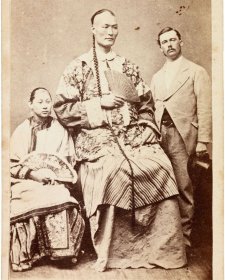- About us
- Support the Gallery
- Venue hire
- Publications
- Research library
- Organisation chart
- Employment
- Contact us
- Make a booking
- Onsite programs
- Online programs
- School visit information
- Learning resources
- Little Darlings
- Professional learning
The portrait of Chang Woo Gow made in 2017 by Pamela See is a papercut silhouette drawing on a pale pink background measuring 48.5 centimetres by 38.5 centimetres in its frame. Two black figures face the same direction presenting their right profile. A large white papercut flower floats in the space above them.
The flower lies on its side, a stem holding two large leaves and a full-blown peony. Delicate cuts in the paper allow the pink of the background to come through and indicate the veins on the leaves and the detail of the rose peony.
Directly below the flower and equal to its size is a small, seated woman. Her hair is in a neat bun and her arms are resting on the arms of the chair. Her long robe sweeps the floor and the fine legs of the chair extend out behind her.
At a slight distance from the seated woman stands a Chinese man, Chang Woo Gow, also in profile. His hair is drawn back in a long braid, and he is dressed in layered long robes. His right hand is stretched out towards his wife’s shoulder, but they do not touch. This creates an interesting negative shape between and around them. As she is seated, she appears to be half his size, emphasizing the radical difference in their height.
The black silhouettes seem to float in space, and the detail of the white papercut flower creates a well-balanced contrast in this work.
Audio description script written by Krysia Kitch and voiced by Kate Matthews
Chang Woo Gow (1840s-1893), known as Chang the Chinese Giant, made the first of his public appearances in London in the mid 1860s. Thousands of people lined up to see his eight foot tall frame and witness his displays of linguistics (he was reportedly able to speak ten languages) and he was soon touring Europe and America. Accompanied by his wife, Kin Foo, he arrived in Australia from the United States in 1870 and toured the country over the next several years. While in Australia, after the death of his first wife, Chang met and married Catherine Santley and returned with her to China. They had two sons before moving to England. He attracted the attention of American showman and entrepreneur P.T Barnum who, in 1880, contracted Chang to join his so-called 'Greatest Show On Earth', a travelling circus, menagerie and museum of freakish human 'specimens'. Returning to England, Chang retired from the stage and, to help cure his suspected tuberculosis, moved with his family to Bournemouth. Here, he opened a tearooms and 'Oriental Bazaar' selling Chinese curios and fabrics. He died, reportedly of a broken heart, four months after the death of his wife in 1893
Purchased 2019
© Pamela See



On one level The Companion talks about the most famous and frontline Australians, but on another it tells us about ourselves.



Karen Vickery on Chang the Chinese giant in Australia.



This exhibition features new works from ten women artists reinterpreting and reimagining elements of Australian history, enriching the contemporary narrative around Australia’s history and biography, reflecting the tradition of storytelling in our country.